Yoga Asana of the day: Virasana (Hero Pose)

Illustration by @Ardgion (click to enlarge)
[Do not attempt this pose if you have a knee injury. Always consult a yoga instructor to see if a pose is safe for you to do. To modify if your knees are weak or you are overweight: keep your hands on the floor on each side of your body or in front of your knees to support most of your bodyweight and gently ease into the pose, and have a cushion between your feet to sit on. Holding for even a split second will bring benefit to your knees, and you can gradually build up the length of time. You can also simply sit on your feet but with your feet slightly wider than your knees to gain the benefits of this pose.]
Kneel on floor, keeping your knees and thighs together; separate your feet by about 18 inches. As you begin to lower your body, take your calf muscles and roll them outwards, to make room for your thighs to lower between your calves. Your hips will be between your feet, and your inner calf will be touching the outer thigh of the same leg.
You probably won't be able to lower all the way at first, it can take a year or more to gain the needed flexibility. Your toes might angle in at first, but over time, the toes will be able to point back.
Keep your hands on the floor on each side of your body if necessary. In time, you can have your hands on your knees in in Gyan mudra, or keep your palms on your knees, as shown in the illustration below:
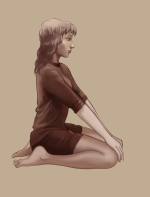
Illustration by @Heather (click to enlarge)
If you are able to sit on the floor, you can then place your hands behind you as in the illustration above and reach your chest upwards. This will help prepare for the extended version of this asana (Supta Virasana).
To get out of this asana: lean forward, place your hands on the floor beside or in front of you, ease up onto your knees and bring your feet together, then stand or sit up.
This asana is very beneficial for the knees and heels. Practiced long-term, it helps treat flat feet be developing the arches of the soles. This is one of the few asanas that can be practiced immediately after eating, it will help digest a full meal, alleviating the heavy feeling in the stomach.
Once you have mastered the above, you can then place a low chair or table behind you to prepare for the full extended version. Use as many cushions or props as necessary for your comfort. The illustration below is leading into the full version (Supta Virasana), which will be posted at a later time:
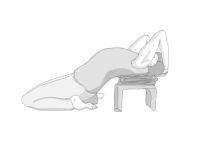
Illustration by @Ardgion (click to enlarge)

Illustration by @Ardgion (click to enlarge)
[Do not attempt this pose if you have a knee injury. Always consult a yoga instructor to see if a pose is safe for you to do. To modify if your knees are weak or you are overweight: keep your hands on the floor on each side of your body or in front of your knees to support most of your bodyweight and gently ease into the pose, and have a cushion between your feet to sit on. Holding for even a split second will bring benefit to your knees, and you can gradually build up the length of time. You can also simply sit on your feet but with your feet slightly wider than your knees to gain the benefits of this pose.]
Kneel on floor, keeping your knees and thighs together; separate your feet by about 18 inches. As you begin to lower your body, take your calf muscles and roll them outwards, to make room for your thighs to lower between your calves. Your hips will be between your feet, and your inner calf will be touching the outer thigh of the same leg.
You probably won't be able to lower all the way at first, it can take a year or more to gain the needed flexibility. Your toes might angle in at first, but over time, the toes will be able to point back.
Keep your hands on the floor on each side of your body if necessary. In time, you can have your hands on your knees in in Gyan mudra, or keep your palms on your knees, as shown in the illustration below:

Illustration by @Heather (click to enlarge)
If you are able to sit on the floor, you can then place your hands behind you as in the illustration above and reach your chest upwards. This will help prepare for the extended version of this asana (Supta Virasana).
To get out of this asana: lean forward, place your hands on the floor beside or in front of you, ease up onto your knees and bring your feet together, then stand or sit up.
This asana is very beneficial for the knees and heels. Practiced long-term, it helps treat flat feet be developing the arches of the soles. This is one of the few asanas that can be practiced immediately after eating, it will help digest a full meal, alleviating the heavy feeling in the stomach.
Once you have mastered the above, you can then place a low chair or table behind you to prepare for the full extended version. Use as many cushions or props as necessary for your comfort. The illustration below is leading into the full version (Supta Virasana), which will be posted at a later time:

Illustration by @Ardgion (click to enlarge)



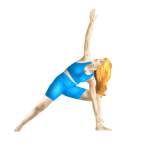
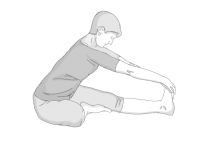
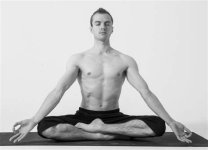


I want to share with you my Digital Art, these beautiful owls:
I will also post them in my "Profile posts".



Reactions: Hake LeQheku 666, Satan's Crow, Dragonheart666 and 2 others